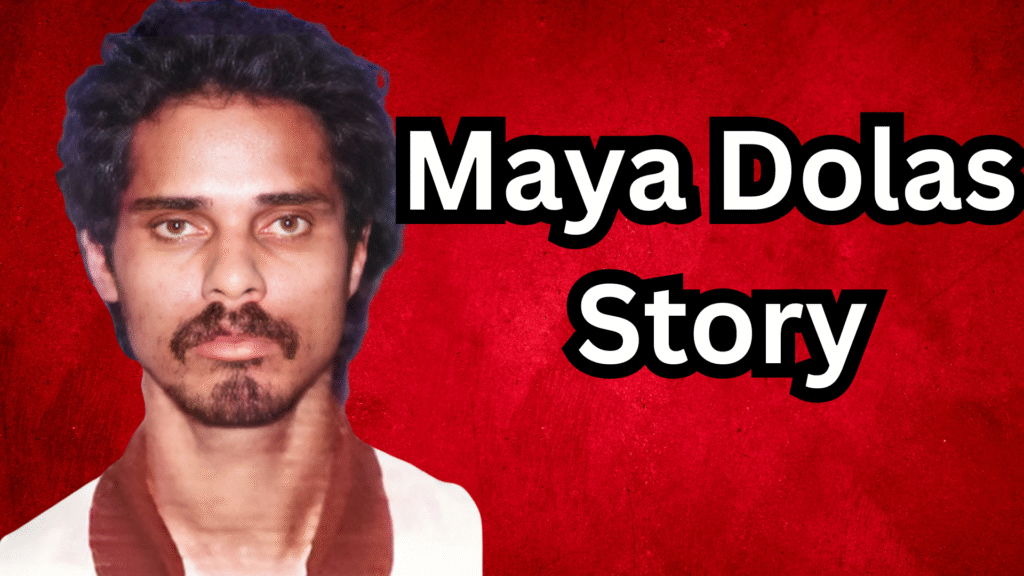“You can’t shoot Maya Dolas like a dog!” – This line, immortalized by Vivek Oberoi in Shootout at Lokhandwala, was more than just cinema. It was a chilling echo of a real man, a real crime, and a city that had once knelt under the shadow of fear.
The Maya Dolas story is not just another tale of crime. It’s a dramatic journey of ambition, betrayal, gang wars, and an explosive end that rewrote Mumbai’s history. While Bollywood dramatized his legacy, the real-life Maya Dolas was more complex — a young man lost in a world that blurred the lines between survival and crime.
The Early Life of Maya Dolas
Born in 1966 in a modest Maharashtrian family in the working-class neighborhood of Lower Parel, Mumbai, Mahindra Dolas (popularly known as Maya Dolas) wasn’t born into crime. His father was a union worker — honest and hard-working. But like many young boys surrounded by poverty, Maya fell prey to the intoxicating world of power, money, and notoriety.
By the late 1980s, Mumbai was rapidly transforming. The glitz of Bollywood masked an underbelly dominated by the mafia — a world where extortion, supari killings, and gang wars were everyday business.
Maya, a school dropout, was a natural rebel. He began as a street-level goon, extorting money for local gamblers. But his sharp mind, fearless attitude, and burning ambition caught the attention of a local gangster, Ashok Joshi, who inducted him into his crime syndicate.
From Street Goon to Gangland Prodigy
It didn’t take long for Maya to climb the ranks. Under Joshi, he led several extortion rackets in the central suburbs. But things took a brutal turn when Joshi was gunned down — allegedly in a hit orchestrated by Dawood Ibrahim’s D-Company.
That death shattered the power vacuum in Mumbai’s underworld. And Maya? He made a bold choice — he joined Dawood Ibrahim, India’s most feared gangster, the man responsible for the 1993 Mumbai bombings and the architect of India’s biggest crime syndicate.
This decision was more than survival — it was a declaration. Maya wanted to be the sultan of the streets, and under Dawood’s patronage, he had access to weapons, money, and an endless web of influence.
The Making of a Legend: Maya Dolas under D-Company
With Dawood’s backing, Maya led a formidable sub-gang along with sharpshooters like Dilip Buwa. Together, they terrorized Mumbai. His operations weren’t just about petty extortion — they involved:
- Real estate takeovers
- Political intimidation
- Contract killings
- Drug trafficking
But unlike many gangsters, Maya was flashy. He flaunted wealth, moved with bodyguards, wore gold chains, and dared to challenge rivals publicly. His arrogance was his armor — and ultimately, his downfall.
In 1991, his overconfidence drew the attention of the Mumbai Police’s Anti-Terrorism Squad (ATS), led by the fiery Aftab Ahmed Khan. This was the beginning of the end.
The Lokhandwala Shootout: Where Maya Dolas Met His Fate
On November 16, 1991, the city of Mumbai witnessed something unprecedented.
In broad daylight, 200 police officers, under Khan’s leadership, surrounded Swati Building in Lokhandwala Complex, Andheri. Inside the apartment were Maya Dolas and his men — heavily armed and ready to die.
What followed was a 4-hour shootout. Thousands of rounds were fired. The building echoed with gunshots, and bystanders crouched in terror. The operation was televised, turning the city into a live warzone.
When the smoke cleared, seven gangsters, such as Maya Dolas, lay lifeless. It was one of the first publicized encounters in Mumbai, and it sparked national debate — was it justice or an extrajudicial execution?
Maya Dolas: Criminal or Cult Hero?
Here’s where the maya (illusion) begins.
While the law saw Maya as a criminal menace, sections of the youth saw him as a rebel, a Robin Hood who took on the system. His rags-to-riches story, his defiance, and his cinematic death became part of Mumbai’s urban folklore.
Movies like Shootout at Lokhandwala turned him into a pop culture icon. The role played by Vivek Oberoi romanticized his courage, even as it blurred moral lines.
But the reality was far darker.
Behind the Legend:
- Maya Dolas was responsible for dozens of contract killings.
- He extorted lakhs from business owners, often through violence.
- He wielded fear as currency in neighborhoods that trembled at his name.
Still, his story endures — not because he was good, but because he symbolized the chaos of a time when crime and power were indistinguishable.
Key Takeaways from the Maya Dolas Story
1. The Underworld’s Influence on Society
The 80s and 90s in Mumbai saw politicians, builders, and even police colluding with the underworld. Maya Dolas was a product of this corruption. His rise reflects how crime thrives when systems fail.
2. Encounter Culture: Justice or Execution?
The Lokhandwala shootout sparked an important verbal exchange on encounter killings. Was Maya’s death a necessity, or did it set a precedent for lawless policing? Even nowadays, this debate rages on.
3. The Allure of Power
Maya’s story also highlights a grim truth — young minds in poverty are often drawn to crime not because of evil, but because of the promise of power and respect that society otherwise denies them.
4. Media’s Role in Creating Myths
Bollywood turned Maya Dolas from gangster to anti-hero. Movies have the power to reshape perception — and often, fiction becomes fact in public memory.
Maya Dolas vs. Other Gangsters: A Quick Comparison
| Feature | Maya Dolas | Dawood Ibrahim | Chhota Rajan |
|---|---|---|---|
| Origin | Lower Parel, Mumbai | Dongri, Mumbai | Chembur, Mumbai |
| Gang Affiliation | D-Company | Founder of D-Company | Split from D-Company (rival) |
| Known For | Lokhandwala Shootout | 1993 Mumbai Bombings | Assassinations of Dawood aides |
| Style | Flashy, Brash, Rebellious | Strategic, Global Operator | Nationalist, Ruthless |
| End | Killed in police encounter | Hiding in Pakistan (alleged) | Arrested, in Indian custody |
Conclusion: More Than Just a Gangster Tale
The Maya Dolas story is gripping because it mirrors society’s darkest corners — poverty, ambition, systemic failure, and the thirst for glory. Maya wasn’t just a criminal; he was a consequence.
His life and death underline the importance of reform — in law enforcement, social justice, and governance. Because as long as power remains inaccessible to the poor, more Mayas will be born.
What’s Your Take?
Does Maya’s journey make him a villain, a victim, or something more complex?
Have films like Shootout at Lokhandwala glorified crime, or simply told uncomfortable truths?
Share your thoughts in the comments below.



